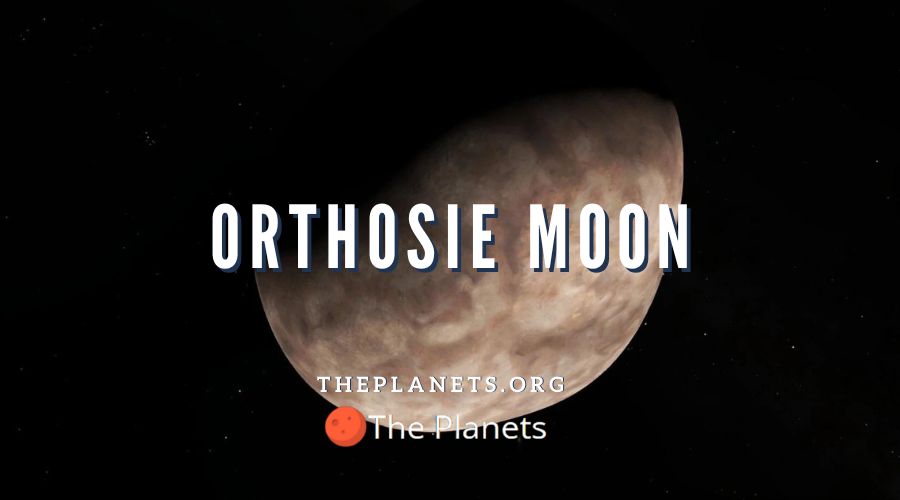
Jupiter travels around the Sun at a great distance from the Earth. Approximately 390,674,710 miles separate the Earth from Jupiter at this time. Consequently, human astronauts would need to journey millions and millions of miles to visit Orthosie in person.
The Discovery of Orthosie
Three scientists from the University of Hawaii discovered Orthosie with the assistance of a powerful telescope and complex laboratory procedures in 2001. Scott S. Sheppard, David C. Jewitt, and Jan T. Kleyna discovered a small moon orbiting in a retrograde direction around the planet Jupiter. They assigned the temporary name S2001 J9 to this satellite.
After studying the moon, scientists belonging to the International Astronomical Union (the “IAU”) gave it the permanent name “Orthosie”. This name ends in the letter “e” to indicate that the moon travels in a retrograde direction.
The Meaning of Orthosie’s Name
The word “Orthosie” comes from the ancient Greek language. It refers to “luck”. At the time, the team of scientists who discovered Orthosie probably felt very lucky to have located such a tiny moon in space orbiting so far away from the Earth. Orthosie is far too small and too far away for people to see by gazing into the night sky.
The Legend of Orthosie
The ancient Greeks believed a goddess named Orthosie oversaw prosperity. The early Romans classified this mythical figure as one of the Hours (or “Horae”). The Horae watched over time and the passage of seasonal events.
The Romans viewed Orthosie as the daughter of a Titaness named “Themis” and the powerful ruler of the gods, Jupiter. Often depicted in ancient statues holding a scale, Themis represented the values of divine justice and order. The ancient Greeks and Romans believed she possessed the ability to foretell the future.
The Appearance of The Moon Orthosie
Today, scientists believe Orthosie appears irregular in shape. This moon does not maintain a smooth spherical appearance at all.(1) Orthosie’s equator extends for only some 6.3 kilometers (or around 3.9 miles). This tiny moon contains a smaller surface area than many large cities on Earth. Orthosie looks like an irregularly shaped chunk of rock orbiting around Jupiter.
Orthosie’s Strange Orbit
Orthosie and the other moons in the Ananke Group travel in “eccentric” orbits. The geometric pattern of this type of orbit resembles an oval-shaped ellipse, not a symmetrical circle. This fact means at different points in time, Orthosie travels closer or further away from the surface of the planet Jupiter.
However, Orthosie orbits Jupiter at an average distance of 13.1 million miles. It does not approach Jupiter’s surface as closely as the Moon approaches the surface of the planet Earth. Orthosie requires about 623 Earth days (almost two years) to orbit completely around Jupiter.
Orthosie And The Ananke Group
Sometimes called “Jovian moons”, the moons of Jupiter may differ from one another in important ways. Scientists classify some of these moons in groups. Orthosie belongs to a set of small retrograde moons called the Ananke Group. All of the moons in this grouping travel in eccentric and retrograde orbits around Jupiter.
Some of the other 14 members of the Ananke Group include: Ananke (the largest moon in the Ananke Group), Euanthe, Euporie, Harpalyke, Helike, Hermippe, Iocaste, Mneme, Praxidike, Thelxinoe, and Thyone. That’s a lot of names to memorize!
The largest moon in the Ananke Group has an average radius of only 14 kilometers (around 8.7 miles). Since Earth’s moon maintains a radius of 1,737.5 kilometers (nearly 1,080 miles), all of the moons in the Ananke Group are much smaller than our planet’s moon.
An Important Point About The Ananke Group
The similarities among the moons in the Ananke Group intrigue scientists. They have searched for ways to explain the small sizes and the irregular shapes of these retrograde moons. Today, most astronomers believe the moons in the Ananke Group once formed part of a large asteroid (a rock drifting in space). This object passed close enough to Jupiter to become trapped by the pull of gravity from the large planet.
Scientists surmise something collided with the asteroid that caused it to split apart. Some of the remnants of the asteroid became the moons of the Ananke Group. This theory would help explain the small sizes and the unusual shapes of this group of Jovian moons.